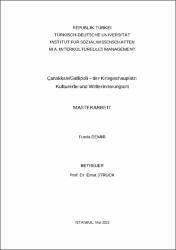| dc.contributor.author | Demir, Funda | |
| dc.date.accessioned | 2024-03-14T17:08:38Z | |
| dc.date.available | 2024-03-14T17:08:38Z | |
| dc.date.issued | 2023 | en_US |
| dc.date.submitted | 2023-06-15 | |
| dc.identifier.citation | Demir, Funda (2023). Çanakkale/Gallipoli - der kriegsschauplatz: kulturerbe und welterinnerungsort. Türk-Alman Üniversitesi, Sosyal Bilimler Enstitüsü, İstanbul. | en_US |
| dc.identifier.uri | https://hdl.handle.net/20.500.12846/805 | |
| dc.description.abstract | The following work deals with the significance of memory sites for the collective
identity of social groups and the location of memories in space.
Aleida and Jan Assmann's theory of collective memory and memory sites builds
on the work of Maurice Halbwachs and Pierre Nora. It examines the processes of the
formation of national memories and the interactions between individual participants. The
focus is on how collective memories serve as the basis of community cohesion and the
importance of places as spatial memory media in the process of national memory
production.
This paper aims to test the applicability of Assmann's theory to the Turkish
context using Gallipoli National Park as an example of spatial objectification of current
Turkish memory culture. By means of a literature review, the memory theories of the
authors are examined in order to conduct an analysis of the applicability of Assmann's
theory to the case study based on the findings. In addition, a site visit to the Gallipoli
National Park will take place. At the beginning of the applicability review, the prehistory
and the Gallipoli War are considered under their political and historical originating
factors. Then, Assmann's theory of memory is analyzed using the example of Gallipoli
National Park as a spatial objectivation to the backward perspective on the Gallipoli War.
In the conclusion, the facts obtained and the resulting findings are critically
examined in order to discuss the research question of this thesis. Assmann's theory of
memory will be applicable to the Turkish context. With regard to the collective memory
described by Aleida Assmann and Jan Assmann, clear tendencies of a state-organized
identity formation become apparent. This master thesis demonstrates the adaptability of
national memory as an identity-forming feature of a nation in the Turkish context | en_US |
| dc.description.abstract | Die folgende Arbeit beschäftigt sich mit der Bedeutung von Erinnerungsorten für
die kollektive Identität von gesellschaftlichen Gruppen und die Verortung von
Erinnerungen im Raum.
Die Theorie von Aleida und Jan Assmann zum kollektiven Gedächtnis und
Gedächtnisorten baut auf den Ausführungen von Maurice Halbwachs und Pierre Nora
auf. Sie untersucht die Prozesse der Bildung nationaler Gedächtnisse und die
Wechselwirkungen zwischen einzelnen Beteiligten. Dabei steht im Fokus, wie kollektive
Gedächtnisse als Basis des Zusammenhalts von Gemeinschaften dienen und welche
Bedeutung Orte als räumliche Gedächtnismedien im Prozess der nationalen
Gedächtnisproduktion einnehmen.
Die vorliegende Arbeit soll die Anwendbarkeit der Assmann’schen Theorie auf
den türkischen Kontext am Beispiel des Nationalparks Gallipoli als räumliche
Objektivation der aktuellen türkischen Erinnerungskultur überprüfen. Anhand einer
Literaturanalyse werden die Gedächtnistheorien der genannten Autoren untersucht, um
anhand der gewonnenen Erkenntnisse eine Analyse der Anwendbarkeit der
Assmannschen Theorie auf das Fallbeispiel durchzuführen. Zudem findet eine
Ortsbegehung zum Nationalpark Gallipoli statt. Zu Beginn der Überprüfung der
Anwendbarkeit werden die Vorgeschichte und der Gallipoli Krieg unter ihren politischen
und historischen Entstehungsfaktoren betrachtet. Anschließend wird die Assmann’sche
Gedächtnistheorie am Beispiel des Nationalparks Gallipoli als räumliche Objektivation
zur Rückwärtsperspektive zum Gallipoli Krieg analysiert.
Im Fazit werden die gewonnenen Fakten und die daraus resultierenden
Erkenntnisse kritisch hinterfragt, um die Fragestellung dieser Arbeit zu erörtern. Die
Assmann’sche Gedächtnistheorie wird auf den türkischen Kontext anwendbar sein. Im
Hinblick auf das von Aleida Assmann und Jan Assmann beschriebene kollektive
Gedächtnis werden klare Tendenzen einer staatlich organisierten Identitätsbildung
erkennbar. Diese Masterthesis zeigt die Anpassungsfähigkeit des nationalen
Gedächtnisses als identitätsstiftendes Merkmal einer Nation im türkischen Kontext auf | en_US |
| dc.language.iso | deu | en_US |
| dc.publisher | Türk-Alman Üniversitesi Sosyal Bilimler Enstitüsü | en_US |
| dc.rights | info:eu-repo/semantics/openAccess | en_US |
| dc.subject | National park gallipoli | en_US |
| dc.subject | Gallipoli war | en_US |
| dc.subject | Memory culture | en_US |
| dc.subject | Assmann | en_US |
| dc.subject | Cultural memory | en_US |
| dc.subject | Memory site | en_US |
| dc.subject | Nationalpark gallipoli | en_US |
| dc.subject | Gallipoli krieg | en_US |
| dc.subject | Erinnerungskultur | en_US |
| dc.subject | Kulturelles Gedächtnis | en_US |
| dc.subject | Gedächtnisort | en_US |
| dc.title | Çanakkale/Gallipoli - der kriegsschauplatz: kulturerbe und welterinnerungsort | en_US |
| dc.type | masterThesis | en_US |
| dc.relation.publicationcategory | Tez | en_US |
| dc.contributor.department | TAÜ, Sosyal Bilimler Enstitüsü, Kültürlerarası Yönetim Ana Bilim Dalı Koleksiyonu | en_US |

















